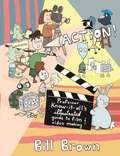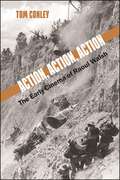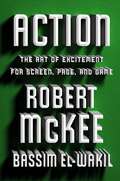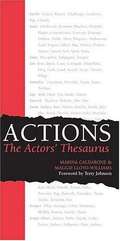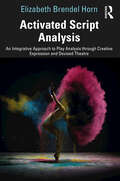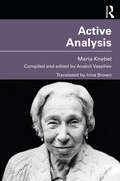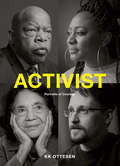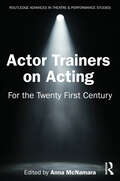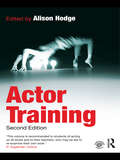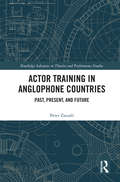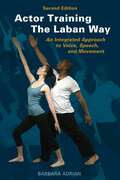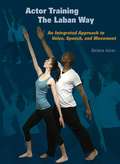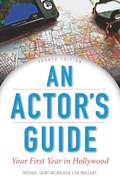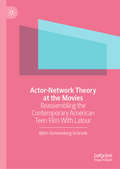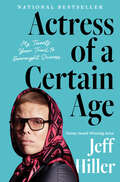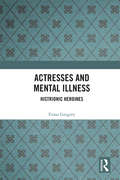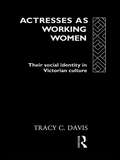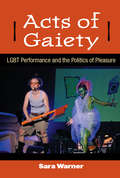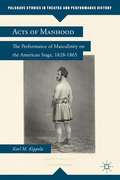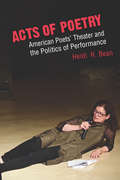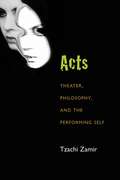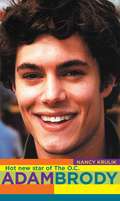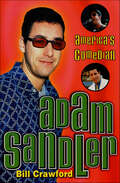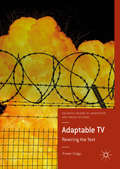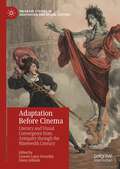- Table View
- List View
Action!: Professor Know-it-all's Guide To Film And Video (Diy Ser.)
by Bill BrownHave you ever wanted to make your own movies? In this easy-to-read and lavishly illustrated volume, you will learn why movies move; how film and video cameras work; how to light and expose your shots to get the best results; how to create eye-pleasing compositions; and how to record crystal clear sounds. It's a do-it-yourself guidebook for film and video makers of all ages and experience levels.
Action, Action, Action: The Early Cinema of Raoul Walsh (SUNY series, Horizons of Cinema)
by Tom ConleyDirector of over 150 films from 1912 to 1964, Raoul Walsh was a core figure in Hollywood from its beginnings to the end of the studio system. Perhaps best known for such films as The Big Trail (starring John Wayne in his first leading role), High Sierra, and White Heat, Walsh cut his teeth under D. W. Griffith, and, like his contemporary John Ford, found a style and signature in his silent cinema and early talkies. Through close analysis of seven of his films, six shot between 1915 and 1933 and one a remake from 1956, and stressing the visual character of their settings and situations, Tom Conley examines how composition and montage—or action—often overtake the crisp narratives these films convey. Rife with contradiction, they ask us to see what makes them possible and how they contend with prevailing codes. Films discussed include Regeneration (1915); Sadie Thompson (1928) and a likely avatar, The Revolt of Mamie Stover (1956); The Cock-Eyed World (1929); The Big Trail (1930); Me and My Gal (1932); and The Bowery (1933).
Action: The Art of Excitement for Screen, Page, and Game
by Robert McKee Bassim El-WakilFrom the master of Story, Dialogue, and Character, ACTION offers writers the keys to propulsive storytelling. ACTION explores the ways that a modern-day writer can successfully tell an action story that not only stands apart, but wins the war on clichés. Teaming up with the former co-host of The Story Toolkit, Bassim El-Wakil, legendary story lecturer Robert McKee guides writers to award-winning originality by deconstructing the action genre, illuminating the challenges, and, more importantly, demonstrating how to master the demands of plot with surprising beats of innovation and ingenuity.Topics include: Understanding the Four Core Elements of ActionCreating the Action CastHook, Hold, Pay Off: Design in ActionThe Action MacguffinAction Set PiecesThe Sixteen Action SubgenresA must-add to the McKee storytelling library, ACTION illustrates the principles of narrative drive with precision and clarity by referencing the most popular action movies of our time including: Die Hard, The Star Wars Saga, Dark Knight, The Matrix, and Avengers: Endgame.
Actions: The Actors' Thesaurus
by Marina Caldarone Maggie Lloyd-WilliamsThis book is an essential companion for actors in rehearsal - a thesaurus of action words to revitalize performance.
Activated Script Analysis: An Integrative Approach to Play Analysis through Creative Expression and Devised Theatre
by Elizabeth Brendel HornActivated Script Analysis engages theatre students in traditional formative script analysis through a fusion of devised theatre and various modes of creative expression, dispelling the notion of script analysis as an isolated pen-to-paper task and reimagining it as a captivating and collaborative process. This book uses diverse, contemporary plays to model the script analysis process for each of four Theatrical Elements: Given Circumstances; Character; Setting; and Structure. By considering each of these elements, readers can uncover patterns and themes within a dramatic text. Woven throughout the study of each theatrical element are "Connections": Personal Connections, which encourage readers to explore a theatrical element within their own lives, as though their lives were a script; Play Connections, which make abstract ideas presented in script analysis concrete through theatre-based play; Professional Connections, which examine how a theatre professional might analyze a script within their own work; and Performative Connections, which provide the opportunity for students to explore a theatrical element through performance using devised theatre strategies. At the end of each chapter, readers are given the opportunity to analyze a text through the lens of a Theatrical Element and to express their findings through a variety of digital, written, visual, and performance-based modes of expression. Activated Script Analysis is designed for undergraduate theatre students and educators, to be used as the primary text in Script Analysis coursework or as a supplemental text in Acting or Directing courses. The book includes access to downloadable templates and example videos, available at www.routledge.com/9781032125398.
Active Analysis
by Maria KnebelActive Analysis combines two of Maria Knebel’s most important books, On Active Analysis of the Play and the Role and The Word in the Actor’s Creative Work, in a single edition conceived and edited by one of Knebel's most famous students, the renowned theatre and film director, Anatoli Vassiliev. This is the first English translation of an important and authoritative fragment of the great Stanislavski jigsaw. A landmark publication. This book is an indispensable resource for professional directors, student directors, actors and researchers interested in Stanislavski, directing, rehearsal methods and theatre studies more generally.
Activist: Portraits of Courage
by KK OttesenA speech on the radio. A high school literature class. A promise made to a mother.Activism begins in small ways and in unexpected places. In this inspiring book, over forty activists from Billie Jean King to Senator Bernie Sanders and Grover Norquist to Al Sharpton recount the experiences that sparked their journeys and share the beliefs that keep them going. These are citizens who met challenge with action. Their visions for peace, equality, and justice have reshaped American society—from voting to reproductive rights, and from the environment to the economy.• Brings together multiple generations from different (sometimes opposite perspectives)• Features KK Ottesen's luminous photographs revealing passion, purpose and optimism• Powerful narratives that collective remind us that anyone can take the future into their own handsFans of 1960Now, Martha Rosler: Irrespective, and Charles White: A Retrospective will love this book. This book is perfect for:• Activists, old and new• Politically engaged readers • Photography fans• Millennials
Actor Trainers on Acting: For the Twenty First Century (Routledge Advances in Theatre & Performance Studies)
by Anna McNamaraActor Trainers on Acting is a comprehensive, diverse and forwardthinking examination of the craft of acting written by leading experts from across the world.The book reflects on the evolving relationship between actor training and the contemporary and future world and considers how directly actor training relates to the living experiences of its stakeholders. Examining the training provider’s role in looking forward to a sustainable and resilient future, this book considers what opportunities there are to be created within performance training and what can be done to enable them. Seeking to provide those teaching, facilitating and leading performance training with ideas and practical steps, this book will be invaluable to students, teachers, practitioners and academics alike.Each chapter features an interview and reflection from leaders drawn from actor training resulting in innovative and insightful individual chapters. The progression is structured to consciously develop the central theme, outlining approaches to contemporary actor training that respond directly to our times globally, building on the foundations of traditions and utilising learning to embolden a confident and resilient training for future students, teachers and industries.
Actor Training
by Alison HodgeActor Training expands on Alison Hodge's highly-acclaimed and best-selling Twentieth Century Actor Training. This exciting second edition radically updates the original book making it even more valuable for any student of the history and practice of actor training. The bibliography is brought right up to date and many chapters are revised. In addition, eight more practitioners are included - and forty more photographs - to create a stunningly comprehensive study. The practitioners included are: Stella Adler; Eugenio Barba; Augusto Boal; Anne Bogart; Bertolt Brecht; Peter Brook; Michael Chekhov; Joseph Chaikin; Jacques Copeau; Philippe Gaulier; Jerzy Grotowski; Maria Knebel; Jacques Lecoq; Joan Littlewood; Sanford Meisner; Vsevolod Meyerhold; Ariane Mnouchkine; Monika Pagneux; Michel Saint-Denis; Włodzimierz Staniewski; Konstantin Stanislavsky; Lee Strasberg The historical, cultural and political context of each practitioner's work is clearly set out by leading experts and accompanied by an incisive and enlightening analysis of the main principles of their training, practical exercises and key productions. This book is an invaluable introduction to the principles and practice of actor training and its role in shaping modern theatre.
Actor Training in Anglophone Countries: Past, Present and Future (Routledge Advances in Theatre & Performance Studies)
by Peter ZazzaliActor Training in Anglophone Countries offers a firsthand account of the most significant acting programs in English-speaking countries throughout the world. The culmination of archival research and fieldwork spanning six years, it is the only work of its kind that studies the history of actor training from an international perspective. It presents the current moment as crucial for student actors and those who teach them. As the profession continues to change, new and progressive approaches to training have become as urgent as they are necessary. Using drama schools and universities as its subjects of inquiry, this book investigates acting programs in the UK, Ireland, the US, Canada, Australia, and New Zealand. Among the case studies are the Royal Academy of Dramatic Art, National Theatre School of Canada, Western Australian Academy of Performing Arts, and Carnegie Mellon University. All recognized for their distinguished reputations by industry professionals and acting teachers alike, the book examines each program’s pedagogical approach, administrative structure, funding apparatus, and alumni success. In doing so, it identifies the challenges facing acting schools today and offers a new direction for training in the twenty-first century. Actor Training in Anglophone Countries will be of interest to theatre and performance scholars, artists, students, and teachers.
Actor Training the Laban Way (Second Edition): An Integrated Approach to Voice, Speech, and Movement
by Barbara AdrianThe Groundbreaking Actor Training Guide, Enhanced with New Videos and Expert Advice from Acting Professionals Actors, teachers, and students of performing arts: sharpen your skills and release your potential with Actor Training the Laban Way, a groundbreaking approach to physical and vocal movement. Utilizing theories of preeminent movement theorist Rudolf Laban, acting teacher and performer Barbara Adrian integrates voice, speech, and movement training with illustrated individual and group exercises that include: Breath Support Building Dynamic Alignment Expanding Vocal Tone and Range Articulation and Rhythmic Exploration Enhancing Strength and Stamina Improving Balance and Flexibility Developing a Relationship to the Environs Revealing Your Emotional State through Physical and Vocal Action This second edition also includes an all-new chapter of advice from acting professionals on how they deploy these exercises and techniques in their acting preparation, practice, and performance. New appendices offer readers links to video supplements as well as exercises in IPA.Actor Training the Laban Way will make any performer more impulsive, imaginative, and expressive.
Actor Training the Laban Way: An Integrated Approach to Voice, Speech, and Movement
by Barbara Adrian* Individual, partner, and group exercises to make any actor more expressive * Crucial acting tips based on the work of distinguished theorist Rudolf Laban * 65 original illustrations of anatomy and warm-up exercises This in-depth, fully illustrated guide offers a groundbreaking approach to understanding physical and vocal movement that will enable readers to discover how to maximize their potential. Packed with practical exercises for individuals, partners, and group work, this book integrates voice, speech, and movement. Exercises for breath support, tone, range, articulation, dynamic alignment, balance, flexibility, strength, and stamina, as well as building relationships, Actor Training the Laban Way is essential reading for all serious actors, acting teachers, and students.
Actor's Guide: Your First Year in Hollywood
by Lisa Mulcahy Michael St. NicolasFor every actor beginning a career in Hollywood, this indispensable guide will lay out a clear and comprehensible path with tried-and-true advice. Up-to-date resources and new interviews with recently established actors experiencing the current movieland scene--as well as the timeless voices of established actors and industry pros--make this a rich compendium of Hollywood know-how. Delve into the industry with the support from An Actor’s Guide: Your First Year in Hollywood and discover with confidence how to: Find work through a variety of sources Deliver stunning auditions Join SAG-AFTRA Get a great headshot and put together a stunning resume Build your credentials and gain exposure Hone your craft with professional training and classes Snag a top-notch agent Utilize the power of social media From settling into Los Angeles and sticking to a tight budget, to adventures in reality TV and landing the breakthrough parts you came to Hollywood for, any actor eager to learn will get his or her fair share of insider knowledge with this manual and will discover how to create a positive experience while launching an exciting career.
Actor-Network Theory at the Movies: Reassembling the Contemporary American Teen Film With Latour
by Björn Sonnenberg-SchrankThis book is one of the first to apply the theoretical tools proposed by French philosopher Bruno Latour to film studies. Through the example of the Hollywood Teen Film and with a particular focus on Actor-Network Theory (ANT), the book delineates how Teen Film has established itself as one of Hollywood’s most consistent and dynamic genres. While many productions may recycle formulaic patterns, there is also a proliferation of cinematic coming-of-age narratives that are aesthetically and politically progressive, experimental, and complex. The case studies develop a Latourian film semiotics as a flexible analytical approach which raises new questions, not only about the history, types and tropes of teen films, but also about their aesthetics, mediality, and composition. Through an exploration of a wide and diverse range of examples from the past decade, including films by female and African-American directors, urban and rural perspectives, and non-heteronormative sexualities, Actor-Network Theory at the Movies demonstrates how the classic Teen Film canon has been regurgitated, expanded, and renewed.
Actress of a Certain Age: My Twenty-Year Trail to Overnight Success
by Jeff HillerA humorous collection of autobiographical essays from comedian and Somebody Somewhere actor Jeff Hiller, who shares his journey from growing up &“profoundly gay&” in 1980s Texas to his experiences as an inept social worker and how he clawed, scraped, and brawled to Hollywood&’s lower middle-tier. While struggling to find success as an actor and pay the bills, something accidentally happened to Jeff Hiller: he aged. And while it&’s one thing to get older and rest on the laurels of success from the blood, sweat, and tears of your youth, it&’s quite another to be old and have no laurels. At forty, stuck in a temp job making spreadsheets, the dream of becoming a star seemed out of reach. But after twenty-five years of guest roles on TV and performing improv in a grocery store basement, he finally struck gold with a breakout role on HBO&’s Somebody Somewhere, playing Joel—the kind of best friend everyone wishes they had. In his book, Jeff dives into the grit and grind of climbing the Hollywood ladder. It&’s a raw and often hilarious tale of the struggles, triumphs, and humiliations that shaped him into the wonderfully imperfect person he is today. With a mix of awkward charm and heartfelt honesty, Jeff shares his journey: growing up very Lutheran in Texas, navigating bullying as a gay kid, working as a social worker for unhoused youth and HIV prevention, and the endless ups and downs of being a struggling actor. For every one of us who have a dream that we&’re chasing—and chasing, and chasing—his is a funny, moving, and utterly relatable story.
Actresses and Mental Illness: Histrionic Heroines (Interdisciplinary Research in Gender)
by Fiona GregoryActresses and Mental Illness investigates the relationship between the work of the actress and her personal experience of mental illness, from the late nineteenth through to the end of twentieth century. Over the past two decades scholars have made great advances in our understanding of the history of the actress, unearthing the material conditions of her working life, the force of her creative agency and the politics of her reception and representation. By focusing specifically on actresses’ encounters with mental illness, Fiona Gregory builds on this earlier work and significantly supplements it. Through detailed case studies of both well-known and neglected figures in theatre and film history, including Mrs Patrick Campbell, Vivien Leigh, Frances Farmer and Diana Barrymore, it shows how mental illness – actual or supposed – has impacted on actresses’ performances, careers and celebrity. The book covers a range of topics including: representing emotion on stage; the ‘failed’ actress; actresses and addiction; and actresses and psychiatric treatment. Actresses and Mental Illness expands the field of actress studies by showing how consideration of the personal experience of the actress influences our understanding of her work and its reception. The book underscores how the actress can be perceived as a representative public woman, acting as a lens through which we can examine broader attitudes to women and mental illness.
Actresses as Working Women: Their Social Identity in Victorian Culture (Gender in Performance)
by Tracy C. DavisUsing historical evidence as well as personal accounts, Tracy C. Davis examines the reality of conditions for `ordinary' actresses, their working environments, employment patterns and the reasons why acting continued to be such a popular, though insecure, profession. Firmly grounded in Marxist and feminist theory she looks at representations of women on stage, and the meanings associated with and generated by them.
Acts of Gaiety: LGBT Performance and the Politics of Pleasure
by Sara WarnerActs of Gaiety explores the mirthful modes of political performance by LGBT artists, activists, and collectives that have inspired and sustained deadly serious struggles for revolutionary change. The book explores antics such as camp, kitsch, drag, guerrilla theater, zap actions, rallies, manifestos, pageants, and parades alongside more familiar forms of "legitimate theater. " Against queer theory's long-suffering romance with mourning and melancholia and a national agenda that urges homosexuals to renounce pleasure if they want to be taken seriously by mainstream society, Acts of Gaiety seeks to reanimate notions of "gaiety" as a political value for LGBT activism. The book mines the archives of lesbian-feminist activism of the 1960s-70s, highlighting the outrageous gaiety that lay at the center of the social and theatrical performances of the era and uncovering original documents long thought to be lost. Juxtaposing historical figures such as Valerie Solanas and Jill Johnston with more recent performers and activists (including Hothead Paisan, Bitch & Animal, and the Five Lesbian Brothers), Warner shows how reclaiming this largely discarded and disavowed past elucidates possibilities for being and belonging. Acts of Gaiety explores the mutually informing histories of gayness as politics and as joie de vivre, along with the centrality of liveliness to queer performance and protest.
Acts of Manhood
by Karl M. KippolaExploring the performance of masculinity on and off the nineteenth-century American stage, this book looks at the shift from the passionate muscularity to intellectual restraint as not a linear journey toward national refinement; but a multitude of masculinities fighting simultaneously for dominance and recognition.
Acts of Poetry: American Poets' Theater and the Politics of Performance
by Heidi R BeanAmerican poets’ theater emerged in the postwar period alongside the rich, performance-oriented poetry and theater scenes that proliferated on the makeshift stages of urban coffee houses, shared apartments, and underground theaters, yet its significance has been largely overlooked by critics. Acts of Poetry shines a spotlight on poets’ theater’s key groups, practitioners, influencers, and inheritors, such as the Poets’ Theatre, the Living Theatre, Gertrude Stein, Bunny Lang, Frank O’Hara, Amiri Baraka, Carla Harryman, and Suzan-Lori Parks. Heidi R. Bean demonstrates the importance of poets’ theater in the development of twentieth-century theater and performance poetry, and especially evolving notions of the audience’s role in performance, and in narratives of the relationship between performance and everyday life. Drawing on an extensive archive of scripts, production materials, personal correspondence, theater records, interviews, manifestoes, editorials, and reviews, the book captures critical assessments and behind-the-scenes discussions that enrich our understanding of the intertwined histories of American theater and American poetry in the twentieth century.
Acts: Theater, Philosophy, And The Performing Self
by Tzachi ZamirWhy do people act? Why are other people drawn to watch them? How is acting as a performing art related to role-playing outside the theater? As the first philosophical study devoted to acting, Acts: Theater, Philosophy, and the Performing Self sheds light on some of the more evasive aspects of the acting experience— such as the import of the actor's voice, the ethical unease sometimes felt while embodying particular sequences, and the meaning of inspiration. Tzachi Zamir explores acting’s relationship to everyday role-playing through a surprising range of examples of “lived acting,” including pornography, masochism, and eating disorders. By unearthing the deeper mobilizing structures that underlie dissimilar forms of staged and non-staged role-playing, Acts offers a multi-layered meditation on the percolation from acting to life. The book engages questions of theatrical inspiration, the actor’s “energy,” the difference between acting and pretending, the special role of repetition as part of live acting, the audience and its attraction to acting, and the unique significance of the actor’s voice. It examines the embodied nature of the actor’s animation of a fiction, the breakdown of the distinction between what one acts and who one is, and the transition from what one performs into who one is, creating an interdisciplinary meditation on the relationship between life and acting.
Adam Sandler: America's Comedian
by Bill CrawfordFrom the comedy clubs of New York to his big break on "Saturday Night Live" to block-buster films like "Big Daddy" and "Little Nicky" Adam Sandler has left America howling in their seats and peeing in their pants. Sandler has emerged as the decade's most unstoppable comedic-and the ladies love him! But how many people know the story behind this lovable comedic prodigy's ascent to fame? Bill Crawford takes you back to Sandler's childhood in a small New Hampshire Town, where his stand-up routines were always hits with his classmates but not necessarily the teachers! When Adam left his small town to take on the big city at New York University, it wasn't always easy, Sandler performed as a street musician crooning Springsteen songs to commuters, but he was destined to succeed. From his long friendship with then college classmate Tim Herlihy, who went on to co-write all Sandler's movies, to being discovered by Dennis Miller and eventually becoming America's funnyman, Bill Crawford looks behind the headlines and tabloid tales to shed new light on this decade's comedic darling.
Adaptable TV: Rewiring The Text (Palgrave Studies In Adaptation And Visual Culture Series)
by Yvonne GriggsThis book focuses on the significantly under-explored relationship between televisual culture and adaptation studies in what is now commonly regarded as the ‘Golden Age’ of contemporary TV drama. Adaptable TV: Rewiring the Text does not simply concentrate on traditional types of adaptation, such as reboots, remakes and sequels, but broadens the scope of enquiry to examine a diverse range of experimental adaptive types that are emerging within an ever-changing TV landscape. With a particular focus on the serial narrative form, and with case studies that include Penny Dreadful, Fargo, The Night Of and Orange is the New Black, this study is essential reading for anyone who is interested in the complex interplay between television studies and adaptation studies.
Adaptation Before Cinema: Literary and Visual Convergence from Antiquity through the Nineteenth Century (Palgrave Studies in Adaptation and Visual Culture)
by Lissette Lopez Szwydky Glenn JellenikAdaptation Before Cinema highlights a range of pre-cinematic media forms, including theater, novelization, painting and illustration, transmedia art, children’s media, and other literary and visual culture. The book expands the primary scholarly audience of adaptation studies from film and media scholars to literary scholars and cultural critics working across a range of historical periods, genres, forms, and media. In doing so, it underscores the creative diversity of cultural adaptation practiced before cinema came to dominate the critical conversation on adaptation. Collectively, the chapters construct critical bridges between literary history and contemporary media studies, foregrounding diverse practices of adaptation and providing a platform for innovative critical approaches to adaptation, appropriation, or transmedia storytelling popular from the Middle Ages through the invention of cinema. At the same time, they illustrate how these forms of adaptation not only influenced the cinematic adaptation industry of the twentieth century but also continue to inform adaptation practices in the twenty-first century transmedia landscape. Written by scholars with expertise in historical, literary, and cultural scholarship ranging from the medieval period through the nineteenth century, the chapters use discourses developed in contemporary adaptation studies to shed new lights on their respective historical fields, authors, and art forms.
